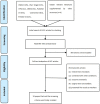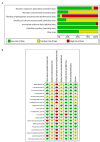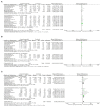Effects of high-intensity and moderate-intensity exercise training on cardiopulmonary function in patients with coronary artery disease: A meta-analysis
- PMID: 36204588
- PMCID: PMC9530785
- DOI: 10.3389/fcvm.2022.961414
Effects of high-intensity and moderate-intensity exercise training on cardiopulmonary function in patients with coronary artery disease: A meta-analysis
Abstract
Purpose: The study aims to evaluate the effects of high-intensity and moderate-intensity exercise training on cardiopulmonary function and exercise endurance in patients with coronary artery diseases (CAD).
Methods: We performed a systematic search of the English and Chinese databases from their inception to March 2022. Randomized controlled trials (RCTs) were included to compare high-intensity and moderate-intensity exercise training on cardiopulmonary function in patients with CAD. The primary outcomes included peak oxygen uptake (peak VO2) and anaerobic threshold (AT). The secondary outcomes included left ventricular ejection fraction (LVEF), exercises duration (ED), respiratory exchange ratio (RER), resting heart rate (RHR), peak heart rate (PHR) and oxygen pulse (O2 pulse). The continuous variables were expressed as mean differences (MD) along with their corresponding standard deviations (SD), and the I2 test was applied in the assessment of heterogeneity.
Results: After systematically literature search, 19 studies were finally selected for our meta-analysis (n = 1,036), with 511 patients in the experimental group (high-intensity exercise) and 525 patients in the control group (moderate-intensity exercise). The results showed that high-intensity exercise significantly increased patients' Peak VO2 [MD = 2.67, 95% CI (2.24, 3.09), P < 0.00001], LVEF [MD = 3.60, 95% CI (2.17, 5.03), P < 0.00001], ED [MD = 37.51, 95% CI (34.02, 41.00), P < 0.00001], PHR [MD = 6.86, 95% CI (4.49, 9.24), P < 0.00001], and O2 pulse [MD = 0.97, 95% CI (0.34, 1.60), P = 0.003] compared with moderate-intensity exercise. However, there were no significant differences in AT [MD = 0.49, 95% CI (-0.12, 1.10), P = 0.11], RER [MD = 0.00, 95% CI (-0.01, 0.02), P = 0.56], and RHR [MD = 1.10, 95% CI (-0.43, 2.63), P = 0.16].
Conclusion: Our results show that high-intensity exercise training has more significant positive effects compared with moderate-intensity exercise training in improving peak VO2, LVEF, ED, PHR and O2 pulse in patients with CAD, while no significant differences were observed in AT, RER and RHR. To sum up, high-intensity exercise training is better than moderate-intensity exercise training in improving cardiopulmonary function and exercise endurance in patients with CAD.
Systematic review registration: PROSPERO (CRD42022328475), https://www.crd.york.ac.uk/PROSPERO/.
Keywords: anaerobic threshold; coronary artery disease; exercise intensity; meta-analysis; peak oxygen uptake.
Copyright © 2022 Zheng, Pan, Gu, Wang, Wu and Xue.
Conflict of interest statement
The authors declare that the research was conducted in the absence of any commercial or financial relationships that could be construed as a potential conflict of interest.
Figures












References
-
- Prabhakaran D, Jeemon P, Sharma M, Roth GA, Johnson C, Harikrishnan S, et al. . The changing patterns of cardiovascular diseases and their risk factors in the states of India: the Global Burden of Disease Study 1990–2016. Lancet Glob Health. (2018) 6:e1339–51. 10.1016/S2214-109X(18)30407-8 - DOI - PMC - PubMed
-
- Ambrosetti M, Abreu A, Corrà U, Davos CH, Hansen D, Frederix I, et al. . Secondary Prevention through Comprehensive Cardiovascular Rehabilitation: From Knowledge to Implementation. 2020 Update. A Position Paper from the Secondary Prevention and Rehabilitation Section of the European Association of Preventive Cardiology. Eur J Prev Cardiol. (2021) 28:460–95. 10.1177/2047487320913379 - DOI - PubMed
-
- Grace F, Herbert P, Elliott AD, Richards J, Beaumont A, Sculthorpe NF. High Intensity interval training (HIIT) improves resting blood pressure, metabolic (Met) capacity and heart rate reserve without compromising cardiac function in sedentary aging men. Exp Gerontol. (2018) 109:75–81. 10.1016/j.exger.2017.05.010 - DOI - PubMed
Publication types
LinkOut - more resources
Full Text Sources
Miscellaneous

